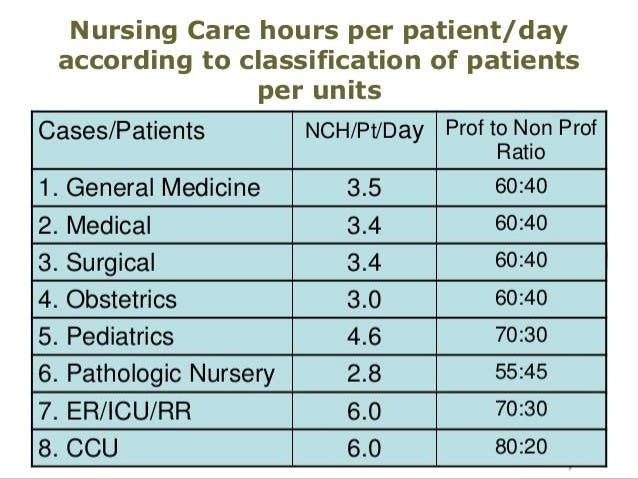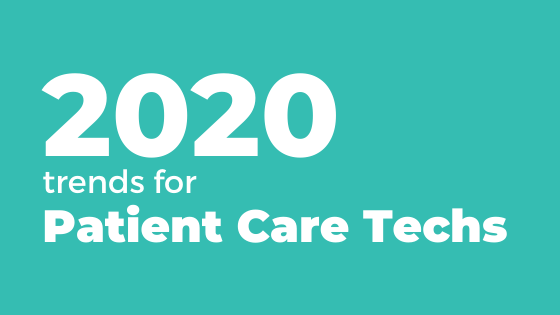Table of Content
DHS does not recommend raising the minimum staffing standard above 3.2 hprd unless empirical data are available to support the conclusion that raising the standard would improve quality of resident care. However, DHS would recommend future consideration of converting the 3.2 hprd standard to a staff-to-resident ratio measure that provides nursing homes the flexibility to meet staffing needs. The report highlights several concerns about the current conditions of the labor market for nursing staff in California.
The committee must develop a plan for nursing ratios for each unit and shift, and provide public notice of this information. A detailed nursing plan must include the level of nursing judgment required, the number of patients, ongoing assessment, and staffing flexibility. The law ensures nurses have enough time to care properly for their patients and no one is overworked. California is currently the only state with mandated nurse-to-patient ratios, which can vary based on the nursing specialty. Understaffing is one of the underlying causes of elder abuse and neglect in nursing homes.
FEDERAL AND STATE MINIMUM STAFFING REQUIREMENTS FOR NURSING HOMES -- OCTOBER 1999 DRAFT
The number of FTE employees and the number of FTE physicians will assist you in determining the number of FTE support staff. Unlike in other industries, where the number of employees per room and hours worked are different, hospitals use the same formula for calculating staff. The total number of hours worked in a week is multiplied by the number of hours worked per day multiplied by the number of days worked in a week.

The author interprets whether or not the Director of Nursing and LN requirements for RNs and LVN/LPNs are separate or a subset of total LN requirements. Introducing legislation requiring nursing homes to post staffing levels by shift where it would be accessible to the public. Each resident requires a minimum of 1.0 hour of direct care per day from a licensed nurse.
Connect with NursingCenter
It’ll cut into other programs at the facility to make up for the increased staffing. Decades of studies have shown that more nurses equate to lives saved and fewer complications. Researchers have been focusing on what exactly is the mediating link between increasing RN staffing and improved outcomes. In this report, National Nurses United describes how the hospital industry has driven registered nurses from the bedside. To assess the impacts of the first minimum nurse-to-patient ratios legislation introduced in 2016, Queensland Health secured the expertise of the world leader in research on nurse-to-patient ratios, the University of Pennsylvania.
There are many nurses across the United States who can tell you stories about being understaffed and overworked with a too-high patient load and poor nurse to patient ratio. California has the highest recorded range of ratios, with as many as 6 patients to one nurse for psychiatric care. To put this in perspective, New York's average nurse-to-patient ratio for psychiatric care is around 3.6. These minimum nurse workforce requirements apply across all Queensland Health RACFs, as prescribed in the Hospital and Health Boards Regulation 2012.
Unsafe Nurse-Patient Staffing Ratios
It is the association’s (N.D.) policy, according to the American Nurses Association. The Department of Professional Employees of the American Federation of Labor and Congress of Industrial Organizations publishes this publication. Discover which states have staffing ratio laws or regulations to help ensure patient safety. Safe RN ratios have been proven to improve the quality of care and nurse recruitment and retention in California hospitals. The Nurse Staffing Standards for Hospital Patient Safety and Quality Care Act would set specific safety limits on the numbers of patients each registered nurse can care for in hospitals throughout the United States. As mentioned above, quality nursing care also improves the overall perception of a hospital facility, as well as outcomes for the patients.
Nursing Homes may use a mix of nurse personnel - Registered Nurses , Licensed Practical Nurses and Certified Nurse Assistants – to provide daily health and other care needs to their residents. The report analyzes deficiency data, including deficiencies due to inadequate staff, from nursing home surveys conducted between May 28, 1998, and March 7, 2000, obtained from OSCAR. Appendix A summarizes state activities for the 50 states plus the District of Columbia. The second report is scheduled to be released in the summer of 2003 and will provide updated information.
The Committee found no relationship between the number of deficiencies issued to a facility and the ratio of direct care hours to nursing home residents. However, one limitation of the data is the inability to control for casemix for each facility. Arkansas passed legislation to increase staffing levels; however, this legislation was neither funded nor implemented. Among these, five states made changes that were technical in nature or reestablished authorization of their standards; however, at the time of the report, Nebraska is developing new regulations.
Whether it’s in an acute care hospital or a long-term care facility, optimal care depends on proper nurse staffing. If nurses are overextended, the quality of care suffers — and lives may even be at risk. For decades, medical professionals have conducted studies and reviewed statistics in an attempt to quantify the ideal number of patients that nurses should be responsible for in various care settings. The vast majority of those states require public disclosure of staffing ratios while others require hospitals to have staffing committees. Nurses, patients, and even healthcare facilities have experienced success when using a safe nurse staffing method.
While they are not strictly regulated, the nurse-to-patient staffing ratios of long-term care facilities are just as important as those in acute care facilities. In a typical nursing home or assisted living setting, nurses care for patients or residents across broad age ranges with extremely diverse medical needs. Read our fact sheet on legislation that would protect patients and improve health care by setting mandated, minimum, registered nurse-to-patient staffing ratios.

Critical care should be treated in California at a ratio of one to eight, whereas less intensive care should be treated in ratios of one to two. A mandated ratio is a rule that requires minimum staffing levels in order to improve patient care. The Queensland Government first legislated minimum nurse-to-patient ratios in the state’s public sector adult acute medical and surgical wards in 2016 to support patient safety and quality of care through appropriate resourcing.
DHS plans to add a component to the federal nursing home survey protocol that will calculate compliance with the 3.2 hprd. About 25% of facilities will be subject to this calculation each year with deficiencies or citations issued to facilities found in non-compliance. The report does not address why only 25% of facilities will be subject to this calculation each year nor how facilities will be selected.
The Healthcare Decisions Group recommends that Connecticut create a nursing staff-to-resident ratio database for use by state regulators in monitoring and enforcing mandated nurse-to-resident ratios in facilities. However, the Group has reservations about the use of such a database without a means of relating staffing ratios to resident outcomes, thus pointing to the need for a resident outcomes database. In addition, the Group recommends compilation of a workforce database based on information from educational institutions, professional licensing databases, and compensation surveys among other sources. This type of database would allow state officials to consider the effects of certain policy initiatives. In 2001, 19 states considered legislation on nursing home staffing and two states adopted minimum standards.
Safe staffing reduces the risk of hospital-acquired infections, decreases the risk of readmission, shortens stays in the hospital, and reduces falls and patient injuries. Short-staffing increases the likelihood that a nurse will experience burnout, and increasing the number of employees leaves a nurse vulnerable to turnover. It has been shown that increasing nurse turnover has resulted in an increase in medication errors, patient safety lapse, and a higher hospital operating cost. In a two-person team, the nurses provide a wide range of support and care to patients.
It can be an effective way for hospital leaders to connect with nursing staff to brainstorm what's working and what's not. When a hospital contracts with our nurse staffing agency, we help to fill a vacant position with a qualified nurse quickly. Nurse-to-patient ratio in New York averages 1 to 6, while nurses in California average 1 to 3.6. Mandated nurse-to-patient ratios in adult acute mental health wards commenced on 15 November 2019.

No comments:
Post a Comment